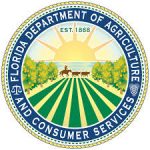
Florida Agriculture Commissioner Nicole “Nikki” Fried today sent a letter to U.S. Department of Agriculture (USDA) Secretary Sonny Perdue strongly opposing the USDA’s decision to allow the import of fresh citrus from China.
In addition to harming the domestic citrus industry by increasing foreign imports, this misguided policy change by USDA’s Animal and Plant Health Inspection Service (APHIS) during the COVID-19 pandemic poses serious risk to the health of Florida’s citrus industry and many other crops. This is due to the potential introduction of devastating invasive pests and diseases found in China. In the past 15 years, Florida’s citrus industry has seen a production drop of 75 percent due to huanglongbing (HLB), commonly known as citrus greening.
The letter from Commissioner Fried reads in part:
“After all that Florida’s industry has overcome and the current challenges facing our farmers, to put our agriculture industry at risk by allowing both the introduction of additional invasive species as well as increased foreign competition is beyond misguided. To kick our agriculture community while they are down, and when our domestic food supply depends on them more than ever, is just plain wrong. I strongly urge the USDA to put the wellbeing of Florida’s and America’s farmers first and rescind this misguided proposal.”
The letter may be downloaded here.
Commissioner Fried also noted that the timing of the USDA’s decision during COVID-19 could exacerbate issues facing Florida’s agriculture community. Fried further stated in the letter:
“The dire situation on the ground due to COVID-19 market disruptions is exacerbating the decades-long impact that illegal dumping of Mexican produce has had on domestic producers of seasonal produce.”
Commissioner Fried was joined by Florida agriculture industry leaders in voicing opposition to the APHIS decision.
“The Florida citrus industry is already facing a devastating non-native disease called HLB that originated in China and has ravaged our groves over the past decade. So the threat is real. We need to take another look at this decision. Add to the fact it will hurt growers by flooding domestic markets with Chinese citrus and it really is a double whammy,” said Florida Citrus Mutual Executive VP and CEO Mike Sparks.
“Florida Farm Bureau appreciates USDA’s work to keep domestic producers in business during the current COVID-19 crisis, but the importation of Chinese citrus will only compound the mounting challenges faced by our growers. Our citrus industry cannot afford this setback,” stated Florida Farm Bureau Federation President John L. Hoblick.
With the updated RMD (Risk Management Documents) in 2019, a total of 22 pests and diseases of quarantine significance were noted from China that could follow the pathway of introduction into the continental United States. These included three different mites, a leaf miner, eight different Bactrocera fruit flies, Asian corn borer, Asian citrus psyllid, a bacterial pathogen causing citrus greening, a bacterial pathogen causing yellowing, a complex of bacteria causing citrus canker, three different fungi (one causing citrus black spot), Citrus bent leaf viroid and Satsuma dwarf virus. All 22 are quarantinable pests and pose a significant risk to Florida’s citrus industry and many other agricultural crops grown in the state including avocado, blueberries, citrus, peaches, peppers, persimmons, tomatoes and many other valuable crops.
- Fruit Fly Risk – In 2015, Florida conducted the largest eradication program for Oriental fruit fly in the history of the state. This introduction occurred in the top agricultural production area of the state. Through genetic analysis, the populations of Oriental fruit fly were traced back to southeast Asia and/or southern China. A total of 165 Oriental fruit flies were trapped and costs for the eradication and impacts to Florida growers well exceeded $10 million. Three years later in 2018, Florida had another outbreak of the Oriental fruit fly requiring a costly eradication program.
-
- A major control component of Florida and California fruit fly eradication programs is the male annihilation technique (MAT) which requires the use of an attractive bait mixed with Spinosad pesticide. There are several species of Bactrocera present in China, including Bactrocera cucurbitae that do not respond to any lure/pesticide combination that can be found on the market. Should one of these species be introduced into Florida eradiation may not be possible.
- Citrus Tan Spot Risk – In addition, several citrus pathogens and fungi were also mentioned in the RMD, any one of which could be disastrous to Florida’s citrus industry. Phyllosticta citriasiana which causes citrus tan spot is a major threat to Florida. The state is currently dealing with a comparable disease Phyllosticta citricarpa causal agent of citrus black spot (CBS), which causes similar symptoms on citrus and as a result has six counties in southwest Florida under quarantine. This quarantine effort for citrus black spot began in 2010 and has had significant economic impacts to citrus growers within the quarantine zone by increasing the overall costs by over $8 million for increased fungicide application and tarping.
- Cold Treatment is not Fail Safe – The proposal to authorize the importation of citrus into all US ports of entry will increase the volume of commodity that could be shipped and increase the risk of cold treatment failure for false codling moth and more importantly, exotic fruit flies. Use of cold treatment as a mitigative strategy is effective for some pests but is by no means full proof. Even without an actual cold treatment failure, fruit flies still occasionally survive these treatments and are even found live in imported fruit. In fact, as recently as December 10, 2019, live Mediterranean fruit flies were found in cold treated grapes from Peru at Hartsfield-Jackson Atlanta International Airport. In the last five years, this has also happened on several occasions with Moroccan clementines. A better mitigative measure to protect state from exotic fruit flies would be irradiation treatment at the point of origin prior to shipment and additionally at a point of destination upon arrival.
